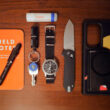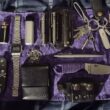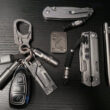From opening boxes to outdoor adventures, a well-chosen blade shape can elevate efficiency, safety, and convenience. Understanding the differences between blade shapes can help you make a more informed decision when deciding which type of knife you should add to your everyday carry. There are various blade shapes tailored for very specific tasks and it can get very confusing. Understanding their benefits and drawbacks is key to making the right choice. Whether you seek a compact blade for urban use or a versatile tool for the outdoors, this guide should help you make your choice.
Popular Knife Blade Shapes
Drop Point Blade
Featured Pick: Vosteed Raccoon
One of the most common types of knives that you’ll come across is the drop point. Some of the most popular everyday carry knives are rocking a drop point. It’s easy to tell a drop point from other knives because they have a characteristic slight slope down the spine ending in a sharp point. This helps with finer cutting work. Drop points are great general-purpose knives used for everything from skinning fish to cutting boxes. Whether you’re on your 20th knife or want one to last you, a drop point knife is always a great option because of its versatility.
Sheepsfoot Blade
Featured Pick: QSP Penguin
Not as common as the drop point, the sheepsfoot blade has a much more unique look. Still, knives with this shape blade tend to find their way into plenty of setups. You can identify these knives by the lack of a sharp tip; instead, opting for a spine that runs parallel to the cutting edge before curving down at a sharp angle to the tip. A sheepsfoot blade is great for cutting tasks like food prep, so they’re commonly found in kitchens on chef’s knives. The lack of a sharp tip makes it difficult for more precise cutting tasks, though, so if that’s what you’re looking for, this probably isn’t for you.
Wharncliffe Blade
Featured Pick: Hogue Deka Magnacut
While most knives have a straight spine with a sharp edge that curves up to meet the point, the wharncliffe does the opposite. It has a straight edge blade that meets a tapered spine at the tip, like a sheepsfoot blade. The spine of these blades is convex, and that, along with the straight edge, makes it a useful utility knife. These blades are used for cutting on flat surfaces or opening boxes. Due to the curved spine, a Wharncliffe is not ideal for piercing or puncturing.
Tanto Blade
Featured Pick: Vosteed Thunderbird
Another common blade shape is the tanto blade. These blades have Japanese origins and are characterized by a sharp, angled tip and a straight spine. They were designed for piercing and stabbing but nowadays can be used for scraping and prying thanks to the chisel-like tip of the blade. Both primary and secondary edges can hold an edge, so whether you need longer slices or more precise cuts, a tanto will get the job done.
Bowie Blade
Featured Pick: CRKT Minimalist
Bowie knives are typically larger, fixed blades named after frontiersman Jim Bowie. They have a clip point-style blade and a cross guard meant to protect the user in a duel, though now it’s way more handy for those intense cutting tasks as it prevents your hand from slipping. In modern times, some Bowie knives even have saw-tooth backs, making them a prime choice for anyone who spends a lot of time outdoors. They typically come with a sheath so that you can either strap it onto your belt, bag, or hang it around your neck, depending on the size.

Reverse Tanto Blade
Featured Pick: CJRB Pyrite
A reverse tanto blade is almost identical to a standard tanto blade, except that the acute angle is opposite the sharp edge. So rather than angling upwards from the belly to meet the blade tip like a standard tanto, these blades point down from the spine. This change in direction makes the spine harder, allowing these knives to be lighter and more durable. Both are great characteristics of any EDC knife.
Clip Point Blade
Featured Pick: Spyderco Para Military 2 MagnaCut
A clip point blade is another common knife type. The identifier on these knives is the blade, which appears clipped off towards the last third of the blade along the spine. The resulting shape ends in a sharp point that’s great for fine cuts. These knives have a thinner spine, which makes it easy to pierce tough materials, but because they are so narrow, they can also break more than some of the other blade shapes if you try to pry something open. Some of the most iconic everyday carry and hunting knives are clip point blades.
Spear Point Blade
Featured Pick: Kershaw Iridium
The spear point is a symmetrical blade great for piercing or thrusting and is also used in some throwing knives. These knives can have one or two sharp edges that meet at the point of the blade. A spear point knife is thicker than needle points, making it more durable and less prone to snapping. These are not ideal for tough chopping jobs as they’re meant for piercing or field dressing.
Gut Hook Blade
Featured Pick: Buck 685 BuckLite Max II
A gut hook knife has one fundamental purpose: gutting game (hence the name). These knives are characterized by a small hook at the blade’s tip that protrudes backward along the spine, allowing a hunter to cut through skin without damaging anything underneath. Due to the specialized nature of these knives, they’re rare in everyday carry but very handy in the field.
Hawkbill Blade/Talon Blade
Featured Pick: CIVIVI Incisor II
Hawkbill knives are so named because they resemble a hawk’s sharp beak (or talons). The spine and the blade’s edge curve sharply downward and meet in a curve that is great for ripping and slicing. Whether you’re cutting through carpet, gardening, or stripping wires, these specialized knives do light work of jobs that would be more difficult with any other type of knife. Again, these are rarer to see in most everyday carry due to the specialized nature of the blade. But they’re generally not uncommon, considering the wide range of use cases for construction and electrical work.
Other blade shapes
Leaf blade: Leaf blade knives are characterized by an elongated, curved blade, making them a versatile option for everyday carry. This is another great kind of knife if you want a solid knife that can handle most everyday tasks. They have a pointed tip for piercing and precision cutting but also have a long edge that makes slicing tasks a breeze as well. Maintenance is also straightforward since the elongated uniform shape has no weird angles. Spyderco is known for these kinds of blades so if you want a leaf blade, you’ll likely end up looking at Spyderco.
Kukri blade: Less common when it comes to everyday carry is the kukri blade. These machete-like recurve blades are the signature weapon of the Indian subcontinent and have been finding a home in the kits of people who spend a lot of time outdoors. These blades are typically large (think over 10″) and have a curved shape that makes them great for hacking branches out of your way and chopping down small trees in a punch. Some modern options even have saw-tooth backs for when sawing something down is more efficient.
Dagger blade: A dagger blade is a short blade characterized by two cutting edges that taper to a sharp point. These are typically designed for use as weapons as they are perfect for thrusting and throwing. For everyday carry, you’ll most likely see dagger blades in automatic knives meant for tactical situations where quick deployment of a sharp blade is essential. These knives will often store the blade in the handle for safety until a button or switch is triggered.
S-Curve blade: S-Curve blades are also fairly rare when it comes to everyday carry knives. These have an exaggerated curve along the belly of the blade for slicing and cutting. The overall shape of the blade bulging out along the edge and then curving upwards back towards the point is where it gets its name from. The shape of the blade is ideal for when you’re cutting through tougher materials as it allows you to rock the blade back and forth rather than needing to saw your way through something.
Reverse S-Curve blade: Then there is the reverse s-curve blade with a curved belly made for push cuts and tougher sawing jobs. The curved spine ends in a hooked tip pointing downwards, adding more cutting area to the blade. That, combined with the contoured handle, makes it hard for the knife to slip. These are great for anyone cutting rope, twine, or opening packages regularly, but the pointed tips on these blades are prone to snapping, so they’re not ideal for tougher outdoor tasks.
Trailing point blade: A trailing point blade is one whose spine curves upward so that the end of the point sits higher than the handle. These knives are typically super lightweight and very skinny. They’re great for food prep as the thin blade lets you easily filet, slice, or skin. They’re great knives for anyone who hunts or fishes often. These are typically fixed blades in everyday carry, but you can also find some folders.
Coping blade: A coping blade is a type of blade used to make cuts in tight spaces. They’re also used for making curved cuts, making them great for working with materials like fabric, carpets, or carpentry. These blades have a straight spine that curves downwards where it meets the sharp edge.
Dao blade: The shape of the Dao blade used in everyday carry draws inspiration from old Chinese swords with large single-edged blades. These modern Dao blades are small enough to fit in your pocket and are typically used for slicing thanks to their elongated and slightly sloped belly. Functionally, these are similar to wharncliffe or sheepsfoot blades where the spine slopes down towards the sharp edge.
Nessmuk blade: The Nessmuk blade offers you a good grip thanks to its deep belly and the subtle bump along the spine that makes these blades great for slicing or cutting. These are a solid option for the outdoors as they’re versatile blade shapes that can handle gutting, skinning, or just cutting through small branches. Nessmuk blades aren’t super common, but they’re not impossible to find.
Spanto blade: If you took a tanto and a spearpoint knife and mashed them together, you’d get a Spanto. The name “Spanto” is just a portmanteau of the two words. This hybrid blade shape is great for EDC as it isn’t tapered, just like tanto blades, but still has a sharp tip and durable cutting edge like a spearpoint. If you can’t decide which kind of knife to go with, maybe getting a combination of two classics is the way to go.
Straight back blade: A straight back is one of the more common blade shapes in the everyday carry community. These are characterized by sharp, straight edges that curve up to meet the blade’s spine. Crucially, the spine of these knives is usually dull, making it a safe place to add pressure for tougher slicing or cutting jobs or even for striking a ferrocerium rod to get sparks going for a fire. These are a common shape in fixed blades that are going to be used outdoors in tough survival situations or for tasks around camp.
Spey point blade: Spey point blades are knives with short bellies and a broad tip. They have sharp edges but very subtle, dull, rounded points. Naturally, these aren’t ideal for piercing and are meant more for sweeping knife strokes like skinning or cutting through wire. The lack of a sharp point is a feature as it allows hunters to skin animals without accidentally piercing the pelt.
Knife Blade FAQs
Which blade style is best?
If you’re looking for versatility and not a blade with a particular purpose, then it’s best to stick to the basics. A drop point or clip point blade will get the job done for most things and are more than durable enough for EDC.
What is the strongest knife shape?
The drop point knife will be the most durable for most people. Most blade shapes have a tough cutting edge, but the drop point blade has a strong tip that will resist most strenuous work. Just try not to use it to pry too much.
What blade shape is best for self-defense?
The best blade shape for self-defense is the dagger. Not only because they are easy to find in tactical OTF knives but also because they have a sharp point meant for piercing.
How we picked
Decades of experience and deep connections in the everyday carry industry give us a unique viewpoint on the market to inform our product recommendations. We have the depth of information for thousands of products that have come before and an extensive eye on the market to see what’s new and trending for each piece of gear. The result is a buying guide that we feel is informative and useful for EDCers of every trade, industry, and budget.
What is Everyday Carry?
Everyday Carry is both the concept of what people carry in their pockets and the process of picking out gear that thoughtfully considers what one wants or needs in their daily life. It encompasses everything from style to preparedness to utility, meaning an entire industry full of valuable tools and essentials to choose from.
Why you should trust us
Our team has decades of combined experience in all aspects of everyday men’s essentials, from wallets to pens to bags and everything in between, and we know where to find great gear ideas that you may not come across at your local stores or when shopping online. Our expertise in the industry and familiarity with design, materials, and usability help you make more informed choices when it comes to picking up your next piece of gear.


















